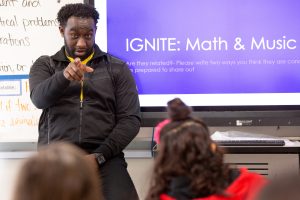How Cognitive Neuroscience Informs Competency-Based Education: A Practical Guide
CompetencyWorks Blog
What makes competency-based education (CBE) truly effective? The answer lies in the science of the brain. Cognitive neuroscience, the study of how the brain learns and processes information, offers critical insights that can help educators refine and enhance CBE practices. By aligning teaching strategies with the brain’s natural learning mechanisms, teachers can create more engaging, effective, and equitable learning environments.
The Power of Autonomy: Letting Students Take the Wheel
At the heart of CBE is the idea that students should have greater control over their learning. This autonomy isn’t just a pedagogical preference – it’s rooted in how the brain works. Cognitive neuroscience shows that when students are given the freedom to make choices about their learning, their brains release dopamine, a neurotransmitter associated with motivation and reward. This chemical response not only boosts engagement but also enhances memory retention.
 When students feel in control, they’re more likely to take healthy learning risks, explore new ideas, and persist through challenges. For teachers, this means shifting from a directive role to a facilitative one. Instead of dictating every step, educators can provide students with options – whether it’s choosing a project topic, deciding how to demonstrate mastery, or setting their own learning pace. This approach not only fosters independence but also helps students develop metacognitive skills, such as self-assessment and reflection, which are critical for lifelong learning.
When students feel in control, they’re more likely to take healthy learning risks, explore new ideas, and persist through challenges. For teachers, this means shifting from a directive role to a facilitative one. Instead of dictating every step, educators can provide students with options – whether it’s choosing a project topic, deciding how to demonstrate mastery, or setting their own learning pace. This approach not only fosters independence but also helps students develop metacognitive skills, such as self-assessment and reflection, which are critical for lifelong learning.
- Learn More & Get Started: Research by Simon Cullen and Daniel Oppenhiemer (2014) Choosing to learn: The importance of student autonomy in higher education highlights how autonomy-supportive educational policies enhance student motivation and mastery of material, while traditional restrictive practices can undermine student engagement and learning outcomes.
Rethinking Assessments: From Stressful Tests to Learning Tools
Traditional assessments often focus more on ranking students than fostering their growth, which can induce anxiety. CBE transforms assessment into a supportive, iterative process designed not merely as a metric of performance but as a mechanism for continuous learning and feedback. This approach is supported by cognitive neuroscience, which highlights the benefits of formative assessments – regular, low-stakes evaluations that provide specific feedback and encourage active retrieval of information. These assessments are not necessarily tied to final grades, reducing test-related stress and allowing students to take ownership of their learning journey. This assessment for learning process not only strengthens neural connections but also enhances long-term memory retention, facilitating a persistent cycle of growth where students can identify both strengths and areas for improvement.

CBE also emphasizes the application of knowledge to real-world contexts, supporting the assessment of higher-order thinking skills and other essential competencies. Performance assessment methods ensure that learning is not only about knowledge acquisition but also about applying this knowledge in practical situations, thereby making education more relevant and empowering for students.
- Learn More: Research by Scott Marion and Paul Leather (2015) Assessment and Accountability to Support Meaningful Learning | Education Policy Analysis Archives examines how competency-based assessments promote deep learning and mastery of skills in students, contrasting traditional models that often prioritize time-based metrics over genuine educational achievements.
Personalized Learning: Meeting Students Where They Are
Personalized learning and CBE go hand in hand. Every student enters the classroom with unique strengths, challenges, and cognitive capacities. Neuroscience underscores the importance of tailoring instruction to these individual differences. For example, some students may have a slower processing speed, while others may struggle with working memory. By understanding these variations, teachers can design lessons that prevent cognitive overload – a state where the brain becomes overwhelmed and learning stalls.

Personalized learning isn’t just about pacing; it’s about aligning instruction with how each student’s brain processes information. When students are challenged at the right level, they’re more likely to stay engaged and retain what they’ve learned. For teachers, this might mean offering differentiated resources, using adaptive technology, or providing one-on-one support. The goal is to create a learning environment where every student feels both challenged and supported.
- Learn more: Research by Ponomarioviene et al. (2025) Implementing Competency-Based Education Through the Personalized Monitoring of Primary Students’ Progress and Assessment explores CBE in primary education, emphasizing personalized monitoring and assessment. This study reveals how CBE enhances student development by encouraging critical thinking and real-life application of learned skills, thereby supporting comprehensive educational growth through tailored assessments and continuous progress monitoring.
Mastery Over Minutes: Why Time Doesn’t Equal Learning
In traditional education, progress is often tied to seat time: students advance based on how many hours they’ve spent in class. CBE flips this model, focusing instead on mastery. Students move forward when they’ve demonstrated a deep understanding of the material. Neuroscience supports this approach, demonstrating that meaningful learning arises from thorough engagement and reflective mastery of content, not merely through prolonged repetition to extend classroom time.
![]()
 Mastery-based learning strengthens neural pathways by encouraging students to engage with material in multiple contexts. This not only deepens understanding but also makes knowledge more transferable to real-world situations. For teachers, this means designing lessons that allow students to apply concepts in various ways – through projects, discussions, or real-world problem-solving. It also requires a shift in mindset: success isn’t about covering the curriculum quickly but ensuring that every student truly grasps the content.
Mastery-based learning strengthens neural pathways by encouraging students to engage with material in multiple contexts. This not only deepens understanding but also makes knowledge more transferable to real-world situations. For teachers, this means designing lessons that allow students to apply concepts in various ways – through projects, discussions, or real-world problem-solving. It also requires a shift in mindset: success isn’t about covering the curriculum quickly but ensuring that every student truly grasps the content.
- Learn more: Research by Haynes et al. (2016) Looking Under the Hood of Competency-Based Education explores how CBE settings significantly enhance students’ learning by focusing on mastery over competencies rather than seat-time. This approach not only supports personalized learning and autonomy but also improves intrinsic motivation and learning behaviors, fostering a productive educational environment.
Equity and Inclusion: Building a Brain-Friendly Classroom
CBE’s emphasis on equity aligns closely with findings from cognitive neuroscience. Research shows that students learn best in environments where they feel safe, valued, and supported. Stress and anxiety, on the other hand, can impair cognitive functions like memory and attention.

Emotional security is a prerequisite for effective learning. When students feel included and supported, their brains are better equipped to engage in higher-order thinking. CBE promotes inclusivity by setting clear, transparent goals and providing the resources every student needs to succeed. Teachers can foster this sense of belonging by creating a classroom culture that celebrates diversity, encourages collaboration, and prioritizes mental well-being.
- Learn more: Research by McEwen and Gianaros (2010) – Central role of the brain in stress and adaptation: Links to socioeconomic status, health, and disease highlights how chronic stress impairs brain functions like memory and attention, while supportive environments promote cognitive and emotional well-being.
Conclusion: The Future of Learning Is Brain-Based
By understanding how the brain works, teachers can design more effective, equitable, and engaging learning experiences. CBE isn’t just a new way of teaching – it’s a scientifically grounded approach designed to prepare students for the complexities of the modern world. By equipping students with the autonomy to shape their educational experiences, we not only enhance their current learning capabilities but also bolster their development of lifelong learning skills.
The future of learning isn’t just about what we teach but how we teach it. By aligning our pedagogical practices with the science of the brain, we can unlock the full potential of every student, ensuring that they not only succeed in school but thrive in life. This approach not only enhances academic performance but also prepares students to be adaptable, self-motivated learners capable of navigating the challenges and opportunities of an ever-changing world.
Learn More
- Bringing Education Policy and the Learning Sciences into Alignment
- The Learning Sciences: How the Brain Was Built to Learn
- Science of Learning: The Engine that Powers Competency-Based Schools
 Dorothy Clerk joined the Aurora Institute in September 2024. Originally from Redlands, California, she is a junior at Santa Clara University, double majoring in Biology and Neuroscience. Her growing interest in competency-based education has led her to explore its potential to enhance nationwide student equity and academic achievement.
Dorothy Clerk joined the Aurora Institute in September 2024. Originally from Redlands, California, she is a junior at Santa Clara University, double majoring in Biology and Neuroscience. Her growing interest in competency-based education has led her to explore its potential to enhance nationwide student equity and academic achievement.